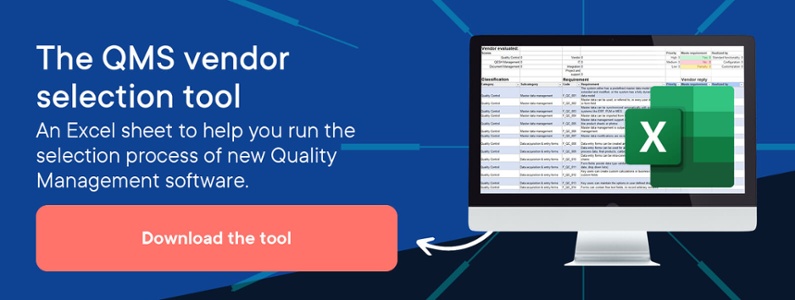The analysts of MarketsAndMarkets, a B2B market research agency published a market review on the global LIMS market. They recognize a significant potential in the LIMS market, but also the technological barriers that restrict this growth. We hear those barriers resonating with our customers and prospects.
Almost double in size
The global annual LIMS market was valued at around $750 million (2018). By 2023, this market is expected to almost double to $1.4B, at a CAGR (Compound annual growth rate) of 12.6%. These numbers represent all LIMS applications, across all industries, and include both software and services. One can argue about the exact numbers, the methodology, or the reputation of those researchers. However, it is undeniably true that the LIMS market is growing, across all verticals and propositions. Let’s not focus too much on the exact numbers but rather stick with the northbound trend.
Services versus software
Traditionally, the LIMS market is a software plus services market. The center of gravity in this estimated growth lies with the services. The large share of the services segment can be attributed to the recurring requirement of services such as training, software upgrading, and software maintenance post-installation.
Drivers for growth
The primary driver for this growth, according to the analysts, is the increased use of LIMS to comply with regulatory requirements. We see the same trend. In addition, we see an increased need to comply with requirements from the market or better said, the customers of our customers. Our customers need to cope with an increased demand for testing, analysis, and reporting. Both regulatory bodies and buyers increase their quality requirements. Coping with these requirements without automation requires increasing your workforce. QA/QC technicians are scarce these days, so this is hardly an alternative.
An additional growth factor brought up in the report by Marketsandmarkets is the adoption of cloud LIMS solutions. The cloud deployment model is expected to register the highest compound annual growth during the forecast period. Factors such as on-demand self-serving analytics, ease of use, affordability, reliability, no upfront capital investment for hardware, adaptability & flexibility, and a pay-as-you-go pricing model have ensured the high growth of cloud-based LIMS. Ease of use, mentioned as one of the advantages of the cloud solution might sound like a minor detail. However, this could be more of an enabler for the cloud transition than one might think. The 2016 and 2017 market surveys by Astrix Technology Group name ease of use and simplified overviews as desired features for new LIMS. 26% of the interviewed LIMS users call ease of use as their top challenge to address. This makes sense, as with the scarcity of QA/QC technicians, making their lives easier as well as enabling other people to contribute to the QA/QC process will eliminate some of their burdens.
Restraining factors
Even though the market is expected to almost double in five years’ time, the market does not meet up to its full potential. According to the analysts, there are factors restraining the growth. The first being the high costs for maintenance and service. This limits the wider adoption of LIMS across industries. Extensive customization of LIMS systems results in relatively high maintenance costs. The Astrix survey clearly defines the need for customization of many LIMS applications as a red flag for future LIMS projects. The lack of integration standards limits growth. In modern IT landscapes, there is no place for stand-alone silos. LIMS systems are often connected with ERP and MES or SCADA, to fully integrate into the digital business processes. Lack of integration, and lack of standardization in this integration, make organizations reluctant in implementing a (new) LIMS. This is clearly pointed out by Astrix as well. Over 20 percent of their respondents define system integration as a challenge for the future of LIMS.
What you can learn from this review
LIMS buyers can learn a lot from this market review and surveys. While all stakeholders can be very satisfied with the growing market, LIMS suppliers should not rest on their laurels.
As a buyer, you should expand your requirements list with non-functional requirements:
- Cloud architecture and deployment are becoming tablestakes. As many manufacturers only have small IT teams (if any), cloud deployments offer big benefits in terms of IT support needed.
- Open APIs that allow for integration with systems in the broader manufacturing landscape are essential. Even more so: those APIs should be understandable for non-specialist developers. At many manufacturers we see non-IT personnel creating integrations with external systems and instruments.
- Usability is key. Good usability allows your users to operate the LIMS with very low onboarding costs. It also limits the need for customization. This results in very limited maintenance fees.
For a deeper understanding of both functional and non-functional requirements, download our vendor selection tool and its accompanying guide. It contains a list of over 250 requirements, gathered by going through 15+ years of RFI / RFP documents provided to us by your quality management peers.
The Quality Management vendor selection tool
The QMS Selection tool is an Excel sheet to help you run the selection process of new Quality Management software. It follows the framework outlined in our whitepaper How to run a Quality Management System selection project. It contains a maturity model to help you understand where you stand to day, and where you want to go. In addition, the tool contains a list of over 250 requirements, gathered by going through 15+ years of RFI / RFP documents provided to us by your quality management peers. It is a great start for creating and RFP/RFI document.




